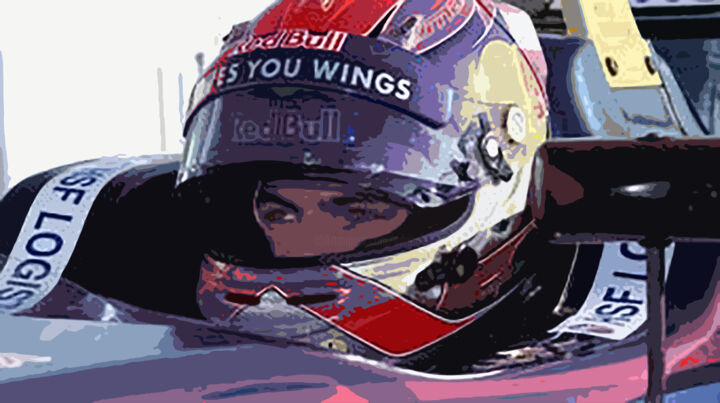"Fine-Arts" prints on paper
It is a process of printing on art paper using very high-quality pigment inks and printed in very high definition. Its level of conservation is exceptional (more than 100 years), its quality, depth, and richness of nuances exceeds the classic photo print on Argentic paper.

Glossy finish
Apart from its exceptional thickness, the fiber paper is composed of an alpha-cellulose base without acid and it is covered with barium sulphate, and a microporous layer absorption enhancing pigments during printing. A pure white color, non-yellowing to light, this paper is especially designed for resistance and aging. It is used by major museums worldwide as it offers excellent resolution, rendering deep and dense colors.
Art Print "Fine Art" - Glossy finish on a fiber base paper 325 g.

Our high end prints and reproductions
ArtMajeur only uses natural papers with neutral pH, resistant, and of high quality, selected from renowned papermakers!
Constant attention is paid by our master printer, whether in terms of color control or respect for the graphic chain. Our high level of quality requirement is a major asset of ArtMajeur framed art prints.
For Artists! You help artists to live from their work. They receive royalties everytime you buy their prints.
About our fine prints-
This work is an "Open Edition"
Digital Arts,
Giclée Print / Digital Print
- Dimensions Several sizes available
- Several supports available (Fine art paper, Metal Print, Canvas Print)
- Framing Framing available (Floating Frame + Under Glass, Frame + Under Acrylic Glass)
- Categories Abstract Everyday Life
Max Verstappen werd geboren op 30 september 1997 in Hasselt, België.[4] Zijn familie heeft sinds lang een band met de autosport: zijn vader, Jos Verstappen, is een Nederlandse voormalig Formule 1-coureur, zijn Belgische moeder, Sophie Kumpen, was actief en succesvol in karting en autocoureur en zijn achterneef Anthony Kumpen is een Belgisch professioneel autocoureur. Verstappen woont sinds oktober 2015 in Monaco.[5]
Hij rijdt zijn wedstrijden met een Nederlandse racelicentie omdat hij naar eigen zeggen zich 'meer Nederlands voelt', meer tijd met zijn vader dan met zijn moeder doorbracht vanwege zijn kartactiviteiten en altijd omringd was door Nederlanders toen hij opgroeide in Maaseik, een Belgische stad aan de Nederlandse grens. Verstappen zei in 2015: “Ik woonde eigenlijk alleen maar in België om te slapen, maar overdag ging ik naar Nederland en had ik daar ook mijn vrienden. Ik ben als Nederlander opgevoed en zo voel ik me ook".
Verstappen begon op vierjarige leeftijd met karten. Vanaf zijn zevende mocht hij deelnemen aan kartwedstrijden. In 2014 maakte hij de overgang naar de autosport. En op 15 maart 2015 maakte hij zijn Formule 1-debuut tijdens de GP van Australië, voor Toro Rosso. Zodoende werd hij op een leeftijd van 17 jaar en 166 dagen de jongste debutant aller tijden binnen de Formule 1. Hij nam meer dan een half seizoen deel aan de Formule 1 voordat hij op zijn 18e verjaardag een rijbewijs voor de weg behaalde.
Een seizoen later behaalde hij op 15 mei 2016 in dienst van Red Bull Racing zijn eerste podiumplaats in een GP, toen hij de GP van Spanje won. Hiermee was hij op een leeftijd van 18 jaar en 228 dagen de jongste leider in een GP, jongste coureur op het podium en jongste winnaar van een GP ooit.
Hij was daarnaast ook de eerste Nederlandse winnaar in de Formule 1, de eerste Nederlander die naar een pole position reed en door het winnen van de Grand Prix van Monaco 2021 als eerste Nederlander de leiding in de WK-stand pakte. Ook gemeten naar het aantal behaalde klassementspunten is Verstappen de meest succesvolle Nederlandse Formule 1-coureur ooit.
Door het succes van Max Verstappen in de Formule 1 nam de publieke belangstelling in Nederland voor de sport enorm toe. Dit zorgde er ook voor dat de Formule 1 weer terugkeerde op het Circuit van Zandvoort. Dit gebeurde in september 2021 na een jaar uitstel door de coronapandemie die in 2020 uitbrak.
Related themes
Art For You
Henk Adriani (Amsterdam, 1952) fine art and photography trained as a photographer at the Fotovakschool and began working in practice at Satina in Amsterdam.
Since 1974 he has been working as an independent photographer. .
In the years that followed Henk began to produce various forms of visual art in which fine art as the photographic technique played a leading role.
From 1986 onwards Henk focused on a different approach to the phenomenon of the image, using painting techniques.
In this working method he found a greater challenge to express his inspiration in a much looser spontaneous and lively way.
Recent works, including those in oil, acrylic, gouache, watercolor and combined techniques, reflect feelings of emotional expression more strongly than is possible with photographic techniques. It is therefore justifiable to speak of "I paint where photography stops".
In most of my works on paper or canvas I use a bright and colorful palette.
There is often no real definitive plan, but there is a global idea, I never work from pre-made sketches or drawings, I experience the subject during the work.
All kinds of changes can be made to the depiction during the entire process of creation.
The images have a recognizable form, sometimes figurative, but very often strongly leaning towards abstract.
Making art in the broadest sense of the word, in principle all materials can be considered for the creation of my art expression: photography, painting, working in ink, charcoal or pastel and various graphic techniques such as etching and screen printing, often in a combined form.
-
Nationality:
NETHERLANDS

- Date of birth : 1952
- Artistic domains: Works by professional artists,
- Groups: Professional Artist Contemporary Dutch Artists








